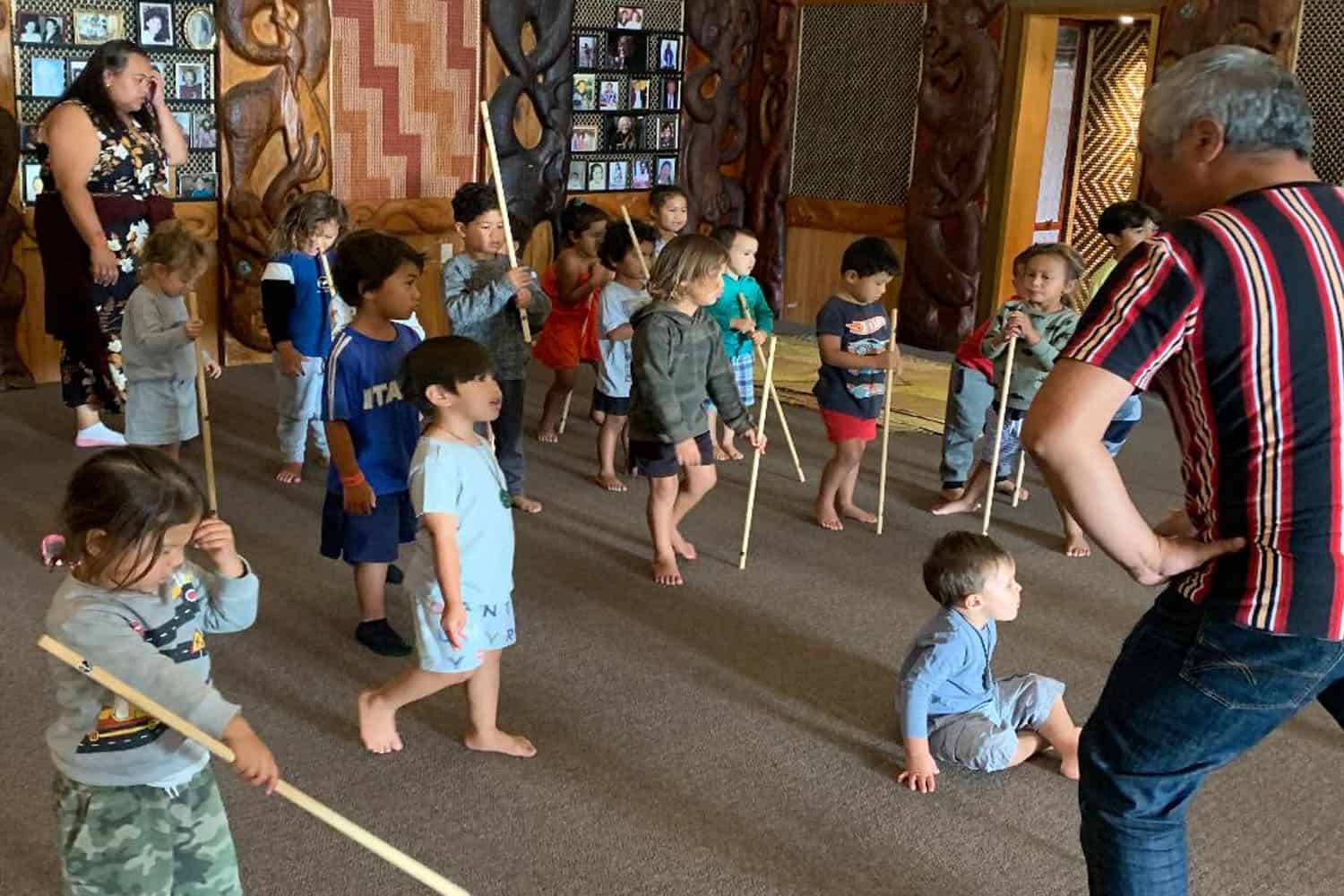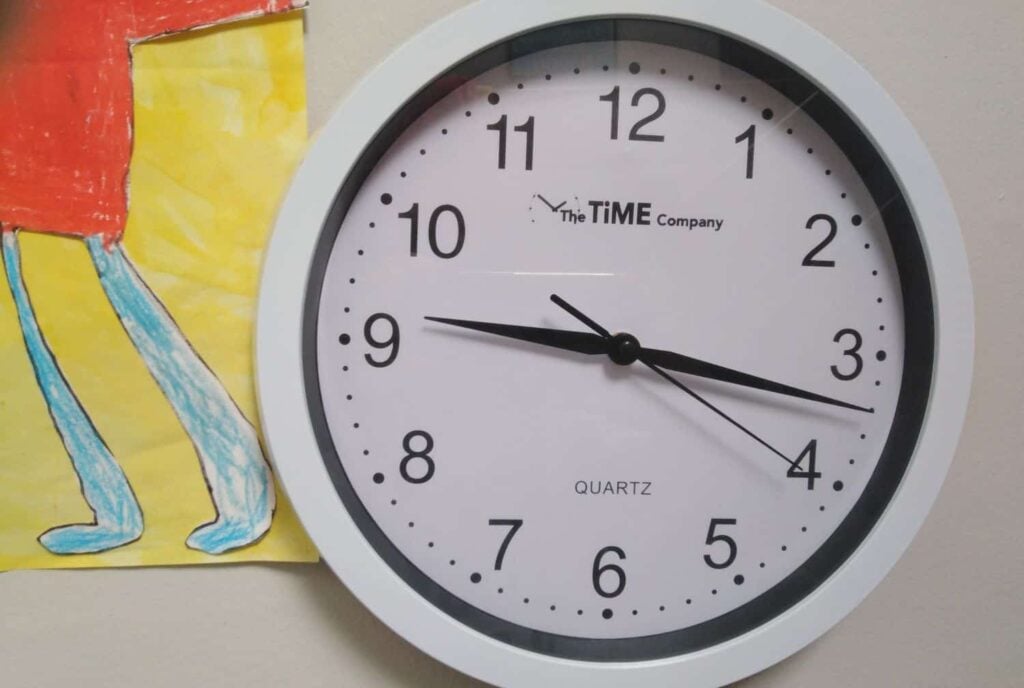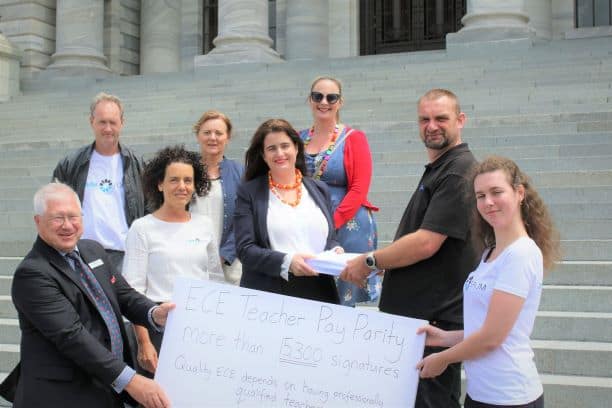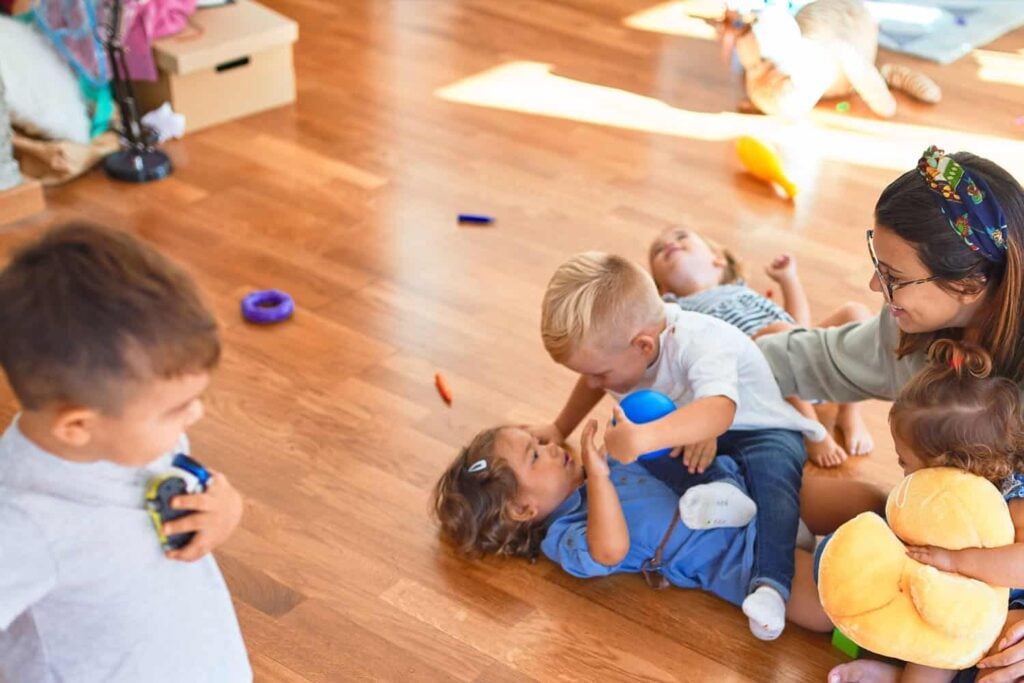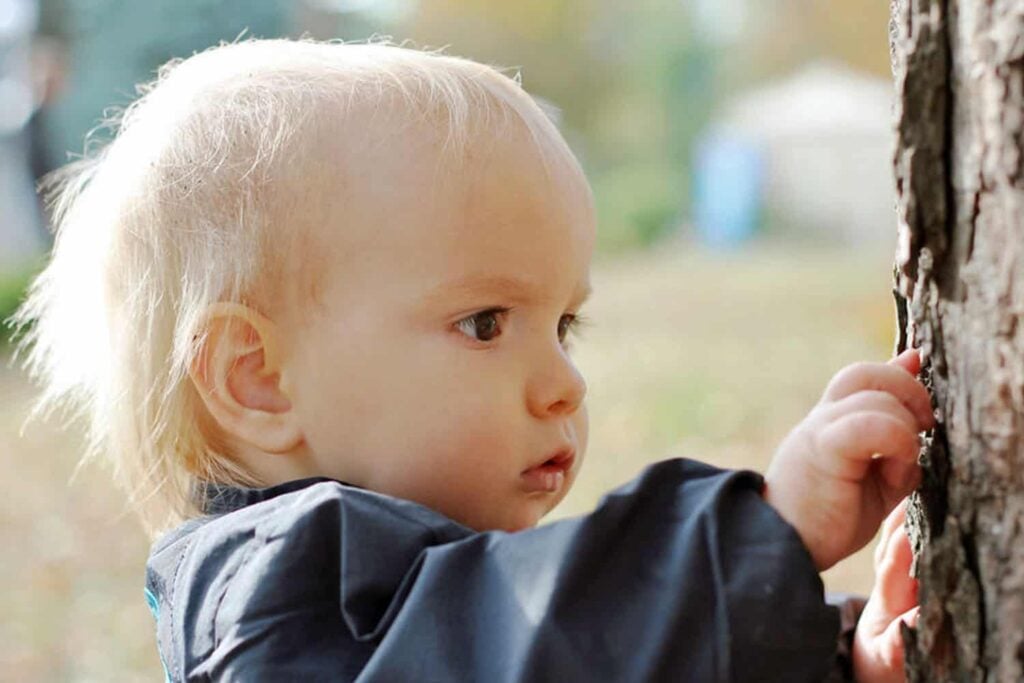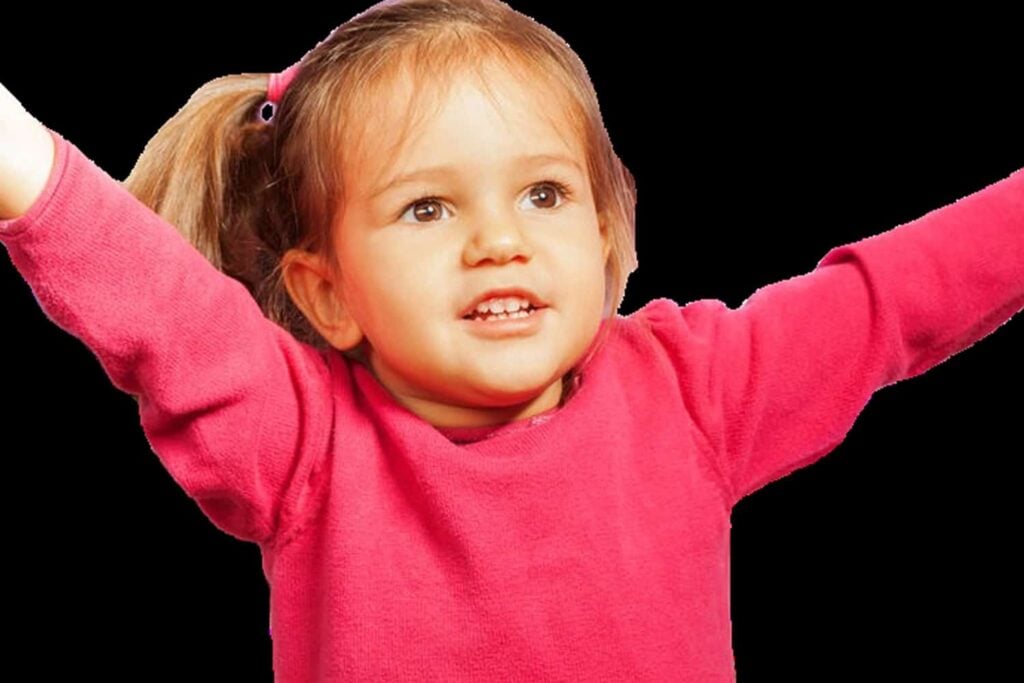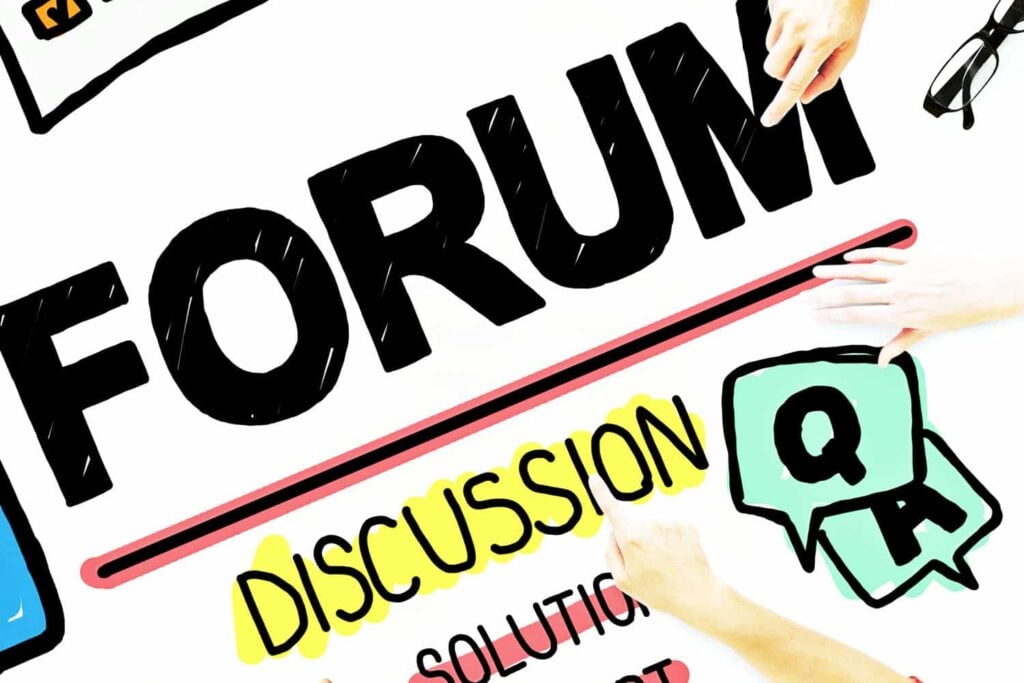Heritage Language Opinion Article.
December 14, 2017.
By Ngaroma M Williams, Rikke Betts and Chrissy Williams.
Despite substantial work involving kaupapa Māori over the last two decades our early childhood sector has not been as active as it could have been in reinforcing the speaking of te reo Māori and bicultural practices.
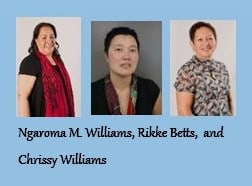
But change is in the air for our heritage language.
Te reo Māori is to be integrated into teaching and children’s learning in every ECE, primary and intermediate school by the year 2025 according to the Associate Minister of Education Māori: Kelvin Davis. And, courses in te reo Māori will be funded for teachers.
The Government’s targeted commitment is a positive move for all teachers as this will allow everyone to grow together in becoming confident and competent teachers of te reo Māori and tikanga Māori.
Ngā Wero – The Arguments
Te Whāriki endorses “…ensuring that te reo Māori not only survives but thrives”. It validates and affirms the importance of ‘kaupapa Māori’: language, culture and cultural values. With substantial work involving kaupapa Māori over the last two decades it is timely to review current teaching practices:
- What actual shifts have occurred?
- How do teachers demonstrate te reo Māori as a living and relevant language within daily practices?
- How do teachers navigate the spaces that advocate for kaupapa Māori in non-Māori domains?
- How are kaupapa Māori values retained?
- How prepared are graduate teachers toward initiating and applying bicultural practices?
Examples of these very questions are apparent in the work and intention of Te Whāriki where Māori and Pākehā worked in co-operation to produce a curriculum document that has influenced ECE in Aotearoa New Zealand over the past two decades. Core values, views and understandings of Kaupapa Māori are woven throughout Te Whāriki, highlighting the critical nature and influence of Māori ways of being, Māori ways of knowing and Māori ways of doing within early childhood education settings.
Despite the significant impact of Te Whāriki within the early childhood sector and the acknowledgement that its Māori authorship was drawn from kaupapa Māori, the place of kaupapa Māori within early childhood environments remains largely in the territory of the unknown. The absence of knowledge of kaupapa Māori in the sector is in itself telling and raises questions in regard to what would seem to be not only a lack of awareness, but also a lack of clear understanding around its key purpose or intent.
While bicultural development has been a focus within ECE settings, research has shown that teachers have found it challenging to deliver bicultural content. Some teachers argue that te reo Māori can be learnt devoid of culture (tikanga) for mere functional or academic purposes. What this means is you end up with the ability to function in the language as an outsider at a minimal level and have no real appreciation for the people who use the language.
Learning te reo Māori without the cultural framework in which it exists is like cooking authentic cuisine without the genuine ingredients, meaning, you lose the essence of a language and its cultural significance. When a teacher decides to learn te reo Māori he or she is not merely absorbing the linguistics of te reo Māori but everything to do with te reo Māori me ōna tikanga (the Māori language and its protocols). The integration of language and culture is always present.
Mauri Ora, Mauri Rere – Striving to Thrive
The early childhood profession, has to some degree struggled to enhance its knowledge and implementation of te reo Māori me ngā tikanga Māori (Māori language and culture) teachings throughout the bicultural curriculum Te Whāriki. This ‘te reo Māori’ Government direction comes at an opportune time as it supports the new teaching and learning propounded in the revised 2017 early childhood bicultural curriculum document. However, the implications for the early childhood profession could now mean consolidating applications of ways of knowing and doing that reaffirms ethical bicultural obligations and traversing new pathways towards meeting te reo Māori me ngā tikanga Māori teaching and learning professional responsibilities by 2025.
Every student and practicing teacher has their personal and professional teaching philosophy therefore we propose the following two questions and solutions for the profession to consider:
- Is this Government initiative just about upskilling and providing professional development for teachers to become confident and competent in the teaching and learning of te reo Māori? Or do teachers have other barriers that still need to be unmasked in order to embark on this journey that requires genuine and authentic buy-in from teachers? Over the past 10 years research has identified that even though Te Whāriki has been around since 1996 and the refreshed version for the past eight months, the early childhood profession still grapples to find ways forward in enacting our Tiriti based curriculum. A thought provoking stance of what this actually means is: the basis of ECE policies, procedures, programmes, practices and pedagogies all embrace bilingualism and biculturalism. The writing has been on the wall for the past three decades that very few teachers provide quality bicultural and bilingual education as part of their obligation of being a professional teacher.
- What needs to happen for the profession so that all teachers have a skill set that allows them to become confident and competent ethical bicultural teachers? Over the past three decades there have been an array of te reo Māori professional development programmes and courses offered and are still being offered to the sector and general public at large by the Government, Tertiary and Community providers. However key issues are evident within the teaching profession for example, teachers (language modellers) who are consistent and confident in speaking te reo Māori in their teaching tend to work in isolation from the rest of their less confident colleagues. These colleagues are relying on this teacher or teachers to model and lead the way with very little commitment made to upskill their own te reo Māori teaching and learning practices as the majority of these colleagues are only:
- using 1-3 word utterances for example: mōrena, kia ora, haere mai, e tū, e noho, hōroi ringaringa, ka pai, ka kite, haere rā, pakipaki, wā whāriki, whakarongo mai;
- incorporating a kupu Māori in context for example: pass the kākāriki paint, let’s go for a hikoi, put your pōtae on, what waiata should we sing, we have āporo today, it is makariri;
Working in isolation is not conducive for these ‘language modelling’ teachers, as in trying to sustain the use of te reo Māori over time a process of assimilation back into the dominant language and culture of the centre occurs – the old saying of “if you don’t use it you lose it’ prevails. The reality is that colleagues of these ‘language modelling teachers’ do not realise they have access to a very important resource that could encourage and enhance daily teaching and learning practices. This then brings to the fore ‘the barrier’ issues for example: “oh I just can’t get the pronunciation…”. Teachers who cite pronunciation barriers are more inclined to stay within their comfort zone neglecting to critically reflect on the barriers they perceive in relation to ‘pronunciation issues’. One of the best ways to overcome pronunciation hindrances is to actually verbalise these because once you have verbalised and identified the barriers then you have something to work on.
There are many assumptions and expectations of how much te reo Māori me ngā tikanga Māori is enough in one’s own practice or service’s programme. The following findings could alert our sector as being quite dormant in our bicultural practices since the launch of Te Whāriki:
- Williams et al (2012) found that the ‘national anthem’ (waiata) of early childhood education programmes is Māhunga, pakahiwi, puku, hope waewae, followed closely by the waiata Pakipaki pakipaki tamariki mā. Five years on and these two waiata still hail as number 1 and 2 in the sector. Both waiata have been around since the 1960’s -57 years later these waiata are still the most used in ECE. This is a clear example of the slow movement to incorporate te reo Māori and tikanga Māori in daily practice in ECE.
- Ritchie and Rau (2006) found that teachers offered smatterings of te reo Māori within their daily practices an example that confirms this is the reading of pukapuka in te reo Māori that had sentences of 6+ words such as:
- He aha tēnei tae? He kākāriki.
- He aha tēnei āhua? He porowhita.
- He aha tēnei kararehe? He kurī.
- E hia ngā putiputi? E waru ngā putiputi.
- Kei hea te paua? Kei runga i te toka.
Such pukapuka are a challenge for teachers who are not confident in using te reo Māori instead the common practice is to continue in English: “What shape is this? The answer could include one te reo Māori word usually the object: “yes it is a porowhita”. For a number of ECE services limited te reo Māori resources could be found around the different curriculum areas such as CD’s and posters of waiata, Kei a wai games at the puzzle area and books tended to be bilingual, poi, rākau, dolls and dress-ups were available but the ability to use te reo Māori within the contexts of these resources could be viewed as disappointing..
- Williams et al (2012) highlighted that teachers had varying understandings of what tikanga practices were, with the majority of their student teachers in their research referring to these as rules, such as:
- We don’t touch children’s heads.
- We don’t sit on tables.
- We don’t step over children.
- We sleep children head to head.
- We use te reo Māori.
These can all be tikanga practices that centres indeed practice however when questioned why these tikanga practices were used, responses referred to health, hygiene and safety reasons. Tikanga practices literally means the ‘right way of doing things’ what this means is you must be able to align your tikanga practices to kaupapa Māori principles or theories of understanding as:
- i to iii can be underpinned by ‘tapu’ or more specifically te tapu o te tinana’;
- iv refers to both te tapu o te tinana and also te taha tinana (physical environment); and
- v was very broadly discussed therefore if you use te reo Māori greetings as a core part of your arrivals then yes this is a tikanga practice and the principle that could underpin this would be whanaungatanga.
There is a lot of goodwill within the profession therefore this Government initiative needs to be concentrated on effective and tailored professional development programmes for the profession to grow in confidence and competence within the seven-year timeframe 2018-2025. The key consideration for effective professional learning development needs to employ collaborative approaches thus, ensuring positive outcomes for all.
Examples of concentrated te reo Māori and tikanga Māori courses are:
- Absolute learner course (vocabulary building >2000 words, pronunciation confidence, knowledge of 5 tikanga principles and a range of tikanga practices reflective of these)
- Confident learner course (vocabulary building >4000 words, pronunciation confidence, knowledge of 10 tikanga principles and a range of tikanga practice reflective of these)
- Intermediate course (can use a range of te reo Māori phrases across 5 curriculum areas, can create own te reo Māori pukapuka series 6-8, can sing 10 waiata unaided, articulation of tikanga practices at any given time, all confident and competent applications)
- Confident Intermediate course (can use a range of te reo Māori phrases across all areas of the curriculum (<15), can create a range of te reo Māori rauemi (resources: games, books, board stories), has a repertoire of >15 waiata, articulation of tikanga practices at any given time, all confident and competent applications)
- Fluent speaker course: Programme and language planning.
Kōrero Whakakapi – Conclusion
In this article we assert the legacy of an indigenous language and culture that are firmly bound to the land, the histories, the exploits, and also responds to a current Government direction. The government’s targeted commitment is a positive move for all teachers as this will allow everyone to grow together in becoming confident and competent teachers of te reo Māori and tikanga Māori. We urge all teachers to commit to this Government strategy and embrace our nation’s history, cultural values and protocols through fostering the heritage language of this land. A Ngāi Tahu whakataukī “mō tātou a, mo ka uri a muri ake nei” – “for all of us now and for those generations to follow” (2011) encapsulates how as a collective we can work together to ensure the terralingua and cultural mores of Aotearoa, New Zealand will form the basis of our everyday teaching – now and into the future.
Heritage Language References
Betts, R. (2016). ‘It underpins everything’. Early Education, 59, 21-23.
Betts, R. (2010). Neoliberalism and the ‘professional teacher’. Early Education, 55, 22-24.
Bishop, R. (1996). Collaborative Research Stories: Whakawhanaungatanga. Palmerston North, NZ: Dunmore Press.
Davis, K. (2017: 15 November). Acting PM Kelvin Davis committed to integration of te reo Māori in all schools. Retrieved from: https://www.maoritelevision.com/news/politics/acting-pm-kelvin-davis-committed-integration-te-reo-maori-schools
Education Council of New Zealand. (2017). Our code. Our standards. Code of professional responsibility and standards for the teaching profession. Wellington: NZ: Author.
Education Review Office. (2008). Māori children in early childhood: Pilot study. Wellington, NZ: Education Review Office.
Education Review Office. (2010). Success for Māori children in early childhood services: Good practice. Wellington, NZ: Education Review Office.
Education Review Office. (2012). Partnership with whānau Māori in early childhood services. Wellington, NZ: Education Review Office.
Education Review Office. (2013). Working with te whāriki. Wellington, NZ: Education Review Office.
Fleer, M. (2013). Theoretical plurality in curriculum design: The many voices of Te Whāriki and the Early Years Learning Framework (pp.217-233). In J. Nutall (Ed.) Weaving te whāriki 2nd Edition. Wellington, NZ: NZCER Press.
Hotere-Barnes, A. (2015). Generating “non-stupid optimism”: Addressing Pākehā paralysis in Māori educational research. New Zealand Journal of Educational Studies, 50(1), 39-53.
Ministry of Education. (2017). Te whāriki. He whāriki mātauranga mō ngā mokopuna o Aotearoa. Early childhood curriculum. Wellington, NZ: Author.
Ministry of Education. (2013a). Ka hikitia – Accelerating success 2013-2017. The Māori education strategic plan. Wellington, NZ: Author.
Ministry of Education. (2013b). Tau mai te reo. The Māori language in education strategy. Wellington, NZ: Author.
Ministry of Education. (1996). Te whāriki. He whāriki mātauranga mō ngā mokopuna o Aotearoa. Early childhood curriculum. Wellington, NZ: Learning Media.
New Zealand Government. (1858; 1861; 1871). Native Schools Act. Wellington, NZ: Government Print.
New Zealand Government. (1991). The Māori Language Amendment Act. Wellington, NZ: Government Print.
Nuttall, J. (Ed). (2003). Weaving te whāriki – Aotearoa New Zealand’s early childhood curriculum document in theory and practice. Wellington, NZ: NZCER Press.
Pihama, L. (2006). Kaupapa Māori elements. A time for reflection. New Lynn, Tamarki Makaurau: Rautaki Ltd and Māori and Indigenous Analysis Ltd.
Ritchie, J. (2002). It’s becoming part of their knowing: A study of bicultural development in an early childhood teacher education setting in Aotearoa/New Zealand. Unpublished PhD thesis. University of Waikato, Hamilton.
Ritchie, J. & Rau, C. (2006). Whakawhanaungatanga – partnerships in bicultural development in early childhood care and education. Wellington, NZ: Teaching and Learning Research Initiative.
Te One, S. (2013). Te whāriki: Historical accounts and contemporary influences 1990-2012. (pp.7-29). In J. Nutall (Ed.) Weaving te whāriki 2nd Edition. Wellington, NZ: NZCER Press
Te Taura Whiri i te reo Māori. (2012). A history of the Māori language – beginning pre-1840 when Māori was the predominant language in Aotearoa, through to today. Retrieved from: http://www.tetaurawhiri.govt.nz/about-us/history-and-timeline/.
Williams, N.M. with Broadley, M.E. and Te Aho-Lawson, K. (2012). Research report. Ngā taonga whakaako: Bicultural competence in early childhood education. Wellington, NZ: Ako Aotearoa National Centre for Tertiary Teaching Excellence.
Footnote: This article is a continuation from our presentation at the World Indigenous Peoples Conference on Education in Toronto, Canada in July 2017 ‘The challenges to teach Heritage Ethno-linguistics within Early Childhood Education in Aotearoa New Zealand’.


